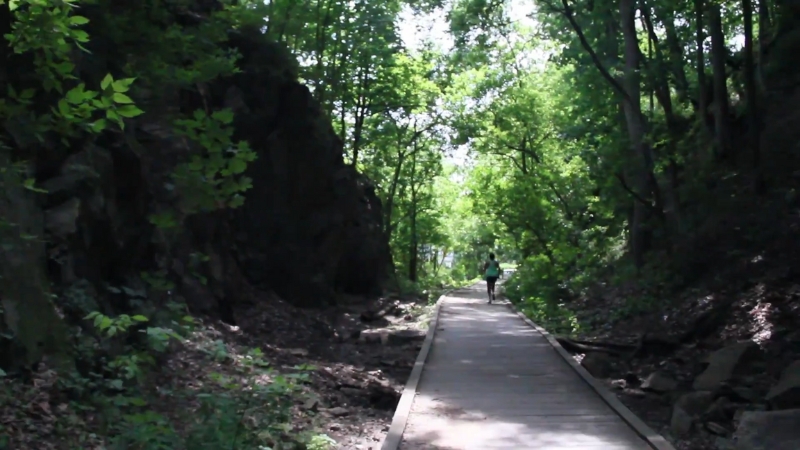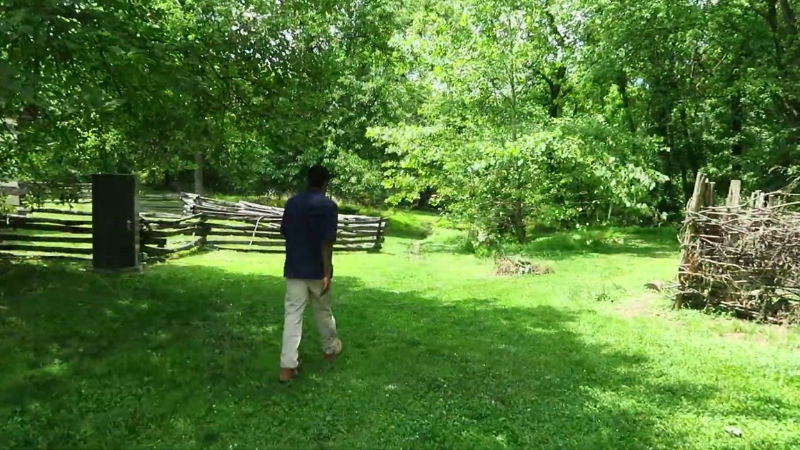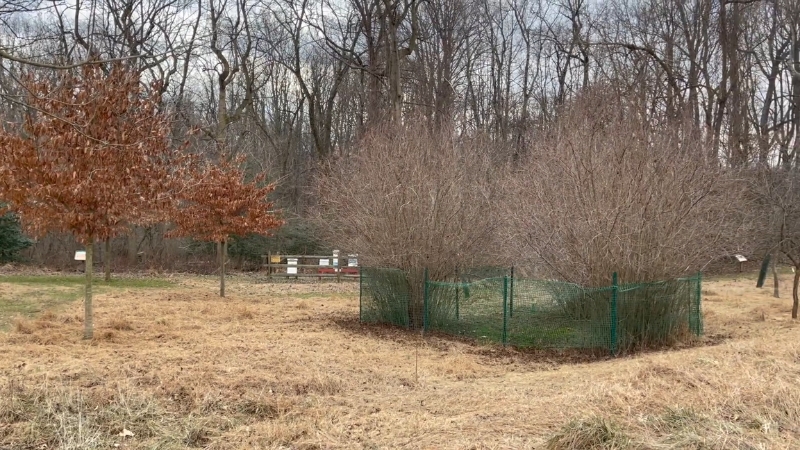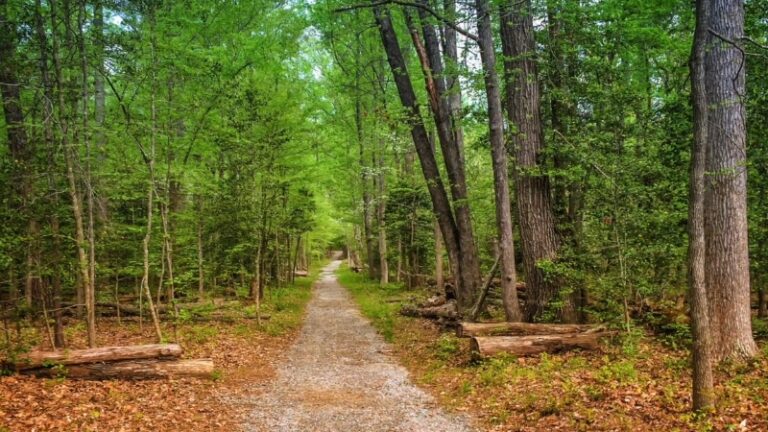Picture yourself walking the same Maryland soil where Benjamin Banneker once gazed at the stars and calculated the movements of celestial bodies. The Banneker Park nature trails invite you to step into history while immersing yourself in the natural world that inspired one of America’s most brilliant minds.
Located in Catonsville, Maryland, Benjamin Banneker Historical Park spans 142 acres of preserved countryside where visitors can experience both the natural beauty that shaped a genius and the seasonal transformations that continue to captivate modern explorers.
Each trail winds through landscapes that tell two stories: the remarkable life of a self-taught astronomer and mathematician, and the eternal cycle of seasons that he studied with such precision.
The park’s trail system offers something extraordinary for every visitor, whether you seek spring wildflowers, summer family adventures, autumn spectacles, or winter solitude. Walk here, and you walk where history was made under the same canopy of trees that sheltered a man who dared to dream beyond the limitations of his time.
Discovering the Trail Network at Banneker Park

The main trail forms a gentle one-mile loop that begins behind the museum and meanders through the varied landscapes of the park.
According to the Baltimore County Recreation Department, the trail system includes multiple interconnected routes: the Heritage Loop, Ice Pond Trail, Ridge Trail, and Nature Trail, each offering unique perspectives on both natural beauty and historical significance.
The elevation gain of just 114 feet makes the trails accessible to families with young children and visitors of all fitness levels. The trail design intentionally creates opportunities for contemplation, much like Banneker himself would have appreciated during his solitary walks through these same woodlands.
Park managers maintain the trails year-round, ensuring safe passage for the thousands of visitors who come to experience both natural wonder and historical connection. The trail markings guide you through diverse habitats while interpretive signs share stories of both ecological relationships and human achievement.
My first visit to these trails revealed something remarkable: the same sense of peaceful observation that must have drawn Banneker to his scientific pursuits. The trails create natural pauses where visitors can stop, look, and truly see the world around them.
Spring Awakens: March Through May Magic

Spring transforms the Banneker Park hiking trails into nature’s laboratory, much as it did for Banneker when he studied seasonal patterns for his almanacs. The first wildflowers emerge along trail edges in March, creating the same conditions that would have inspired Banneker’s detailed observations of natural cycles.
According to research from the Baltimore Ecosystem Study, urban forest ecosystems like those found at Banneker Park show remarkable resilience and biodiversity, with spring representing the most dynamic period of ecological activity.
April brings dramatic changes as trees leaf out and migratory birds return, filling the air with the sounds that would have accompanied Banneker’s morning walks.
The seasonal trail guide Maryland naturalists developed shows May as the peak month for spring activity. During my spring visits, I’ve watched families discover their first trillium blooms along the Heritage Loop and listened to children ask the same questions about nature that must have driven Banneker’s curiosity centuries ago.
Early morning visits provide the best opportunities for wildlife observation, when the forest awakens with bird songs and the gentle movement of small mammals.
The Nature Trail becomes particularly magical during these dawn hours, as morning light filters through emerging leaves in patterns that would have fascinated the astronomer who spent his nights studying light from distant stars.
Photography opportunities abound as spring blossoms create perfect backdrops for capturing seasonal beauty. Educational programs at the museum combine perfectly with trail exploration.
Summer Adventures: June Through August

Summer brings lush canopy cover to the park, creating natural shade that makes summer nature activities in Banneker Park comfortable even during warm Maryland days. The dense foliage transforms the trails into green tunnels of tranquility, offering respite from urban heat just as these woodlands once provided Banneker with cool spaces for contemplation.
During June, the forest reaches full maturity, creating the kind of verdant environment that supported Banneker’s agricultural work and inspired his weather observations. July represents peak growing season, when the interconnected ecosystems demonstrate the complex relationships that fascinated early naturalists like Banneker.
According to naturalists at nearby Marshy Point Nature Center, summer months provide ideal conditions for family nature programs, with longer daylight hours and peak wildlife activity creating optimal conditions for outdoor education.
August extends the season with established wildlife patterns and mature plant communities that showcase ecosystem stability.
My summer experiences on these trails have taught me the value of early morning visits. The tree canopy provides excellent shade, but the forest truly comes alive before 10 AM, when cooler temperatures bring increased animal activity and comfortable conditions for extended exploration.
The Ice Pond Trail becomes particularly interesting during summer months, when the interplay between water, forest, and meadow creates microclimates that support diverse plant and animal communities. Families often use this trail for nature scavenger hunts, discovering the same kinds of natural phenomena that once captured Banneker’s scientific attention.
Autumn Glory: September Through November

Autumn at Banneker Park creates the kind of spectacular natural display that would have provided Banneker with perfect conditions for his almanac calculations. The fall foliage Banneker trails transform the landscape into a living painting of gold, scarlet, and amber hues.
September marks the beginning of the autumn transformation, when select tree species begin their color change in patterns that follow the same natural rhythms Banneker recorded in his weather observations. October delivers peak foliage conditions, creating the stunning displays that draw photographers and nature lovers from across the region.
According to research from the Baltimore Ecosystem Study, autumn represents a critical period for wildlife preparation activities. November extends the season with late-changing species and provides excellent opportunities for observing the winter preparation behaviors that would have informed Banneker’s understanding of natural cycles.
The Ridge Trail offers the best vantage points for autumn photography, where elevation changes provide panoramic views of the color transformation. During my autumn visits, I’ve found that the combination of historical reflection and natural beauty creates moments of profound connection to both the past and the present.
Wildlife activity increases significantly during autumn months as animals prepare for winter. The reduced insect activity creates better conditions for extended trail exploration, while the changing light conditions provide excellent opportunities for both photography and quiet observation.
Winter Contemplation: December Through February
Winter walks in Maryland parks offer the same kind of solitary reflection that characterized Banneker’s most productive periods of scientific work. The bare trees create enhanced visibility throughout the forest, revealing landscape features and wildlife activity patterns that remain hidden during leafy seasons.
December brings the early winter transition, when the forest structure becomes visible and tracking animal movements becomes possible for observant visitors. January typically provides the most challenging weather conditions but rewards hardy visitors with peaceful solitude and unique natural experiences.
Maryland winters create ideal conditions for understanding the same weather patterns that Banneker incorporated into his almanac predictions. February begins the subtle transition toward spring, when careful observers can detect the first hints of seasonal change in tree bud development and wildlife behavior patterns.
The winter landscape reveals the park’s topography clearly, allowing visitors to better comprehend the relationship between different habitats and trail systems. During my winter visits, I’ve discovered that the bare forest provides unobstructed views of the same geological features that would have influenced Banneker’s understanding of local geography.
Winter trail conditions require appropriate preparation but offer rewards unavailable during other seasons. The reduced visitor numbers create opportunities for contemplative experiences similar to those that supported Banneker’s most important scientific work.
Accessible Trails for Every Family
The trail system design prioritizes accessibility, making outdoor recreation in Banneker Park available to visitors with varying mobility levels and interests. The main loop provides the most accessible option with minimal elevation change and well-maintained surfaces suitable for wheelchairs and strollers.
Park planners intentionally created multiple entry and exit points that allow families to customize trip lengths based on children’s ages and energy levels. The wide paths and gentle grades make the trails suitable for multi-generational groups, enabling grandparents to share outdoor experiences with young children.
During my visits with families, I’ve observed how the trail design encourages natural learning opportunities. Children frequently stop to examine interesting rocks, plants, or animal signs, creating teachable moments that mirror Banneker’s curiosity-driven approach to learning about the natural world.
View this post on Instagram
The proximity to museum facilities adds educational value to trail experiences. Restroom availability, parking convenience, and interpretive programming create conditions that support extended visits combining outdoor activity with historical education.
Seasonal Wildlife: A Living Laboratory
The diverse habitats within Benjamin Banneker Historical Park support wildlife communities that change dramatically with the seasons, creating the kind of natural laboratory that would have fascinated the park’s namesake. Each habitat area demonstrates different ecological relationships and seasonal adaptation strategies.
According to the Baltimore Ecosystem Study, urban forest preserves like Banneker Park serve as critical wildlife corridors and provide essential habitat for both resident and migratory species.
Spring migration brings dozens of bird species through the park, creating opportunities to observe the same natural phenomena that informed Banneker’s almanac weather predictions.
Summer breeding activities showcase wildlife behaviors at their most active, when animal families raise young and demonstrate survival strategies. The woodland areas provide homes for various songbird species, while open meadow spaces support different plant and animal communities.
Autumn preparation behaviors reveal how animals gather resources and adapt to changing conditions. Winter observations focus on the species that remain active during cold months and the tracking opportunities that snow conditions provide.
During my regular visits throughout the year, I’ve documented over 40 bird species and numerous mammal signs along the trail system. Each season brings discoveries and deeper appreciation for the ecological complexity that exists within the park boundaries.
Wildlife Observation Calendar
Season
Wildlife Highlights
Optimal Viewing Times
Best Trail Sections
Spring
Migratory birds, nesting activity
Early morning (6-9 AM)
Nature Trail, Heritage Loop
Summer
Breeding behaviors, juvenile animals
Dawn and dusk hours
Ice Pond Trail, Ridge Trail
Autumn
Migration, food gathering
Mid-morning to afternoon
Ridge Trail, Nature Trail
Winter
Tracking, feeding activity
Midday warmest hours
Heritage Loop, Ice Pond Trail
Navigation and Trail Maps
The park participates in Baltimore County’s comprehensive trail mapping program, providing detailed information about trail connections, difficulty levels, and points of historical and natural interest. Physical maps available at the museum entrance include GPS coordinates and emergency contact information.
Trail blazes use color-coded systems that maintain clear directional guidance throughout the park. The marking system accommodates visitors using various navigation methods, including traditional map reading and modern GPS technology.
Emergency procedures and contact information are posted at strategic locations throughout the trail system. Cell phone coverage remains reliable in most areas, providing additional safety support for solo visitors or groups with special needs.
Digital resources complement physical signage, allowing visitors to access additional information about both natural features and historical significance. The integration of technology with traditional navigation methods creates flexible options for different visitor preferences.
Planning Your Perfect Visit
@chacharetro The Benjamin Banneker Historical Park in Ellicott City Maryland #park #outdoor #benjaminbanneker #history #nature ♬ original sound – chacharetro
The best time to visit Banneker Park depends on your interests in both natural phenomena and historical reflection. Each season offers unique advantages that connect visitors to different aspects of Banneker’s life and scientific work.
According to park management data, the park welcomes visitors year-round, with sunrise to sunset hours making it ideal for anyone seeking early morning walks or afternoon exploration among trees and streams. Spring visits emphasize renewal and growth, making them perfect for educational programs and family activities.
Summer visits maximize daylight hours for extended exploration, while autumn provides peak visual beauty during comfortable hiking weather. Winter offers solitude and unique perspectives that mirror the contemplative conditions Banneker required for his most important scientific work.
My recommendation involves multiple visits throughout the year to fully appreciate the seasonal changes that so fascinated Benjamin Banneker. Each season reveals different aspects of the natural world and creates different opportunities for reflection and discovery.
Seasonal Planning Guide for Optimal Experiences
Season
Primary Benefits
Weather Considerations
Recommended Activities
Spring
Wildflowers, migration
Variable conditions, layered clothing
Nature photography, birdwatching
Summer
Family activities, extended daylight
Heat precautions, early visits
Educational programs, long hikes
Autumn
Peak beauty, comfortable temperatures
Increased visitors, parking challenges
Photography, contemplative walks
Winter
Solitude, unique perspectives
Cold preparation, shorter days
Tracking, historical reflection
The Benjamin Banneker Historical Park nature trails offer year-round opportunities to walk in the footsteps of genius while experiencing the same natural beauty that inspired one of America’s most remarkable minds.
Each visit provides new opportunities for discovery, learning, and connection to both natural cycles and human achievement. Come prepared for seasonal conditions, but more importantly, come prepared to be amazed by the enduring power of curiosity and the timeless beauty of the natural world.

